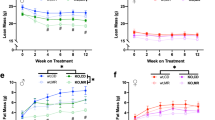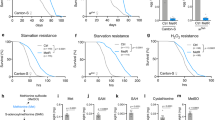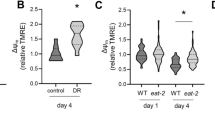Abstract
Methionine restriction (MR) extends lifespan in various model organisms, and understanding the molecular effectors of MR could expand the repertoire of tools targeting the aging process. Here, we address to what extent the biochemical pathway responsible for redox metabolism of methionine plays in regulating the effects of MR on lifespan and health span. Aerobic organisms have evolved methionine sulfoxide reductases to counter the oxidation of the thioether group contained in the essential amino acid methionine. Of these enzymes, methionine sulfoxide reductase A (MsrA) is ubiquitously expressed in mammalian tissues and has subcellular localization in both the cytosol and mitochondria. Loss of MsrA increases sensitivity to oxidative stress and has been associated with increased susceptibility to age-associated pathologies including metabolic dysfunction. We rationalized that limiting the available methionine with MR may place increased importance on methionine redox pathways, and that MsrA may be required to maintain available methionine for its critical uses in cellular homeostasis including protein synthesis, metabolism, and methylation. Using a genetic mutant mouse lacking MsrA, we tested the requirement for this enzyme in the effects of MR on longevity and markers of healthy aging late in life. When initiated in adulthood, we found that MR had minimal effects in males and females regardless of MsrA status. MR had minimal effect on lifespan with the exception of wild-type males where loss of MsrA slightly increased lifespan on MR. We also observed that MR drove an increase in body weight in wild-type mice only, but mice lacking MsrA tended to maintain more stable body weight throughout their lives. We also found that MR had greater benefit to males than females in terms of glucose metabolism and some functional health span assessments, but MsrA generally had minimal impact on these metrics. Frailty was also found to be unaffected by MR or MsrA in aged animals. We found that in general, MsrA was not required for the beneficial effects of MR on longevity and health span.





Similar content being viewed by others
Data availability
The data presented in the work are available from the corresponding author upon request.
References
Sun L, Sadighi Akha AA, Miller RA, Harper JM. Life-span extension in mice by preweaning food restriction and by methionine restriction in Middle Age. J Gerontol A: Biol Sci Med Scis. 2009;64A:711–22.
Richie Jr John P, et al. Methionine restriction increases blood glutathione and longevity in F344 rats. FASEB. 1994;8:1302–7.
Miller Richard A, et al. Methionine-deficient diet extends mouse lifespan, slows immune and lens aging, alters glucose, T4, IGF-I and insulin levels, and increases hepatocyte MIF levels and stress resistance. Aging Cell. 2005;4:119–25.
Guerra Beatriz A, et al. Dietary sulfur amino acid restriction upregulates DICER to confer beneficial effects. Molec Metab. 2019;29:124–35.
Grant Louise, et al. Methionine restriction improves renal insulin signalling in aged kidneys. Mech Aging Dev. 2016;157:35–43.
Lees Emma K, et al. Methionine restriction restores a younger metabolic phenotype in adult mice with alterations in fibroblast growth factor 21. Aging Cell. 2014;13:817–27.
Stone KP, Wanders D, Orgeron M, Cortez CC, Gettys TW. Mechanisms of increased in vivo insulin sensitivity by dietary methionine restriction in mice. Diabetes. 2014;63:3721–33.
Forney LA, Wanders D, Stone KP, Pierse A, Gettys TW. Concentration-dependent linkage of dietary methionine restriction to the components of its metabolic phenotype: concentration dependence of methionine restriction. Obesity. 2017;25:730–8.
Caro P, et al. Forty percent and eighty percent methionine restriction decrease mitochondrial ROS generation and oxidative stress in rat liver. Biogerontology. 2008;9:183–96.
Sanchez-Roman I, et al. Forty percent methionine restriction lowers DNA methylation, complex I ROS generation, and oxidative damage to mtDNA and mitochondrial proteins in rat heart. J Bioenerget Biomembr. 2011;43:699–708.
Sanz A, et al. Methionine restriction decreases mitochondrial oxygen radical generation and leak as well as oxidative damage to mitochondrial DNA and proteins. FASEB J. 2006;20:1064–73.
Wu G, et al. Dietary methionine restriction ameliorated fat accumulation, systemic inflammation, and increased energy metabolism by altering gut microbiota in middle-aged mice administered different fat diets. J Agric Food Chem. 2020;68:7745–56.
Patil Yuvraj N, Dille Kelly N, Burk David H, Cortez Cory C, Gettys Thomas W. Cellular and molecular remodeling of inguinal adipose tissue mitochondria by dietary methionine restriction. J Nutr Biochem. 2015;26:1235–47.
Kozieł Rafał, et al. Methionine restriction slows down senescence in human diploid fibroblasts. Aging Cell. 2014;13:1038–48.
Yoshida S, et al. Role of dietary amino acid balance in diet restriction-mediated lifespan extension, renoprotection, and muscle weakness in aged mice. Aging Cell. 2018;17: e12796.
Zou K, et al. Life span extension by glucose restriction is abrogated by methionine supplementation: Cross-talk between glucose and methionine and implication of methionine as a key regulator of life span. Sci Adv. 2020;6:eaba1306.
Ables GP, Perrone CE, Orentreich D, Orentreich N. Methionine-restricted C57BL/6J mice are resistant to diet-induced obesity and insulin resistance but have low bone density. PLoS ONE. 2012;7: e51357.
Brown-Borg HM, et al. Growth hormone signaling is necessary for lifespan extension by dietary methionine. Aging Cell. 2014;13:1019–27.
Elshorbagy Amany K, et al. Cysteine supplementation reverses methionine restriction effects on rat adiposity: signifi cance of stearoyl-coenzyme A desaturase. J Lipid Res. 2011;52:104–12.
Hens JR, et al. Methionine-restricted diet inhibits growth of MCF10AT1-derived mammary tumors by increasing cell cycle inhibitors in athymic nude mice. BMC Cancer. 2016;16:349.
Forney LA, et al. Sexually dimorphic effects of dietary methionine restriction are dependent on age when the diet is introduced. Obesity. 2020;28:581–9.
Wanders Desiree, et al. FGF21 mediates the thermogenic and insulin-sensitizing effects of dietary methionine restriction but not its effects on hepatic lipid metabolism. Diabetes. 2017;66:858–67.
Scislowski PWD, Davis EJ. Sulfur oxidation of free methionine by oxygen free radicals. FEBS Lett. 1987;224:177–81.
Bentley Ronald. Methionine and derivatives: exploring chirality at sulfur. Biochem Molec Biol Educ. 2005;33:274–6.
Chao C-C, Ma Y-S, Stadtman ER. Modification of protein surface hydrophobicity and methionine oxidation by oxidative systems. Proc Nat Acad Sci. 1997;94:2969–74.
Ciorba MA, Heinemann SH, Weissbach H, Brot N, Hoshi T. Regulation of voltage-dependent K + channels by methionine oxidation: effect of nitric oxide and vitamin C. FEBS Lett. 1999;442:48–52.
Fricke TC, et al. Oxidation of methionine residues activates the high-threshold heat-sensitive ion channel TRPV2. Proc Natl Acad Sci U S A. 2019;116:24359–65.
Brennan LA, Lee W, Giblin FJ, David LL, Kantorow M. Methionine sulfoxide reductase A (MsrA) restores α-crystallin chaperone activity lost upon methionine oxidation. Biochim Biophys Acta (BBA) - General Subjects 2009;1790:1665–1672.
Zhang X-H, Weissbach H. Origin and evolution of the protein-repairing enzymes methionine sulphoxide reductases. Biol Rev. 2008;83:249–57.
Delaye L, Becerra A, Orgel L, Lazcano A. Molecular evolution of peptide methionine sulfoxide reductases (MsrA and MsrB): on the early development of a mechanism that protects against oxidative damage. J Mol Evol. 2007;64:15–32.
Peng-Fei Wu, et al. A specific and rapid colorimetric method to monitor the activity of methionine sulfoxide reductase A. Enzyme Microbial Technol. 2013;53:391–7.
Kwak Geun-Hee, Hwang Kwang Yeon, Kim Hwa-Young. Analyses of methionine sulfoxide reductase activities towards free and peptidyl methionine sulfoxides. Arch Biochem Biophys. 2012;527:1–5.
Salmon AB, et al. Lack of methionine sulfoxide reductase A in mice increases sensitivity to oxidative stress but does not diminish life span. The FASEB Journal. 2009;23:3601–8.
Styskal J, et al. Methionine sulfoxide reductase A affects insulin resistance by protecting insulin receptor function. Free Radical Biol Med. 2013;56:123–32.
Thyne KM, Salmon AB. Metabolic benefits of methionine restriction in adult mice do not require functional methionine sulfoxide reductase A (MsrA). Sci Rep. 2022;12:5073.
Whitehead JC, et al. A clinical frailty index in aging mice: comparisons with frailty index data in humans. J Gerontol: A. 2014;69:621–32.
Dunham NW, Miya TS. A note on a simple apparatus for detecting neurological deficit in rats and mice**College of Pharmacy, University of Nebraska, Lincoln 8. J Am Pharm Assoc (Sci ed). 1957;46:208–9.
Crawley JN. Behavioral phenotyping of rodents. Comp Med. 2003;53:140–6.
International Mouse Phenotyping Consortium. Grip Strength Protocol – IMPReSS. International Mouse Phenotyping Consortium https://www.mousephenotype.org/impress/ProcedureInfo?action=list&procID=1130.
Wang C, Li Q, Redden DT, Weindruch R, Allison DB. Statistical methods for testing effects on “maximum lifespan.” Mech Ageing Dev. 2004;125:629–32.
Swaminathan A, Fokin A, Venckūnas T, Degens H. Methionine restriction plus overload improves skeletal muscle and metabolic health in old mice on a high fat diet. Sci Rep. 2021;11:1260.
Wanders D, et al. Role of GCN2-independent signaling through a noncanonical PERK/NRF2 pathway in the physiological responses to dietary methionine restriction. Diabetes. 2016;65:1499–510.
Malloy VL, et al. Methionine restriction decreases visceral fat mass and preserves insulin action in aging male Fischer 344 rats independent of energy restriction. Aging Cell. 2006;5:305–14.
Rockwood K, et al. A frailty index based on deficit accumulation quantifies mortality risk in humans and in mice. Sci Rep. 2017;7:43068.
Kane AE, et al. Impact of longevity interventions on a validated mouse clinical frailty index. GERONA. 2016;71:333–9.
Richardson NE, et al. Lifelong restriction of dietary branched-chain amino acids has sex-specific benefits for frailty and life span in mice. Nat Aging. 2021;1:73–86.
Schultz MB, et al. Age and life expectancy clocks based on machine learning analysis of mouse frailty. Nat Commun. 2020;11:4618.
Mitchell S, MacArthur M, Kane A, Torrence M, Manning B. Improved healthspan and lifespan with late onset pharmacological or dietary interventions in mice. Innovation in Aging. 2019;3:S875.
Mitchell S, et al. Late-onset pharmacological or dietary interventions improve healthspan and lifespan in male and female mice. Innovation in Aging. 2020;4:125.
del Campo A, et al. Muscle function decline and mitochondria changes in middle age precede sarcopenia in mice. Aging. 2018;10:34–55.
Sayed RKA, et al. Identification of morphological markers of sarcopenia at early stage of aging in skeletal muscle of mice. Experiment Gerontol. 2016;83:22–30.
Bouwknecht JA, Paylor R. Behavioral and physiological mouse assays for anxiety: a survey in nine mouse strains. Behav Brain Res. 2002;136:489–501.
Chinta SJ, et al. Cellular senescence is induced by the environmental neurotoxin paraquat and contributes to neuropathology linked to Parkinson’s disease. Cell Reports. 2018;22:930–40.
Willard AM, Bouchard RS, Gittis AH. Differential degradation of motor deficits during gradual dopamine depletion with 6-hydroxydopamine in mice. Neuroscience. 2015;301:254–67.
Orentreich N, Matias JR, DeFelice A, Zimmerman JA. Low methionine ingestion by rats extends life span. J Nutr. 1993;123:269–74.
Nichenametla SN, Mattocks DAL, Malloy VL. Age-at-onset-dependent effects of sulfur amino acid restriction on markers of growth and stress in male F344 rats. Aging Cell. 2020;19:e13177.
Ruckenstuhl C, et al. Lifespan extension by methionine restriction requires autophagy-dependent vacuolar acidification. PLoS Genet. 2014;10: e1004347.
Pennington SM, et al. Defective protein repair under methionine sulfoxide A deletion drives autophagy and ARE-dependent gene transcription. Redox Biol. 2018;16:401–13.
Zhao H, Kim G, Levine RL. Methionine sulfoxide reductase contributes to meeting dietary methionine requirements. Arch Biochem Biophys. 2012;522:37–43.
Liao C-Y, Rikke BA, Johnson TE, Diaz V, Nelson JF. Genetic variation in the murine lifespan response to dietary restriction: from life extension to life shortening. Aging Cell. 2010;9:92–5.
Rikke BA, Liao C-Y, McQueen MB, Nelson JF, Johnson TE. Genetic dissection of dietary restriction in mice supports the metabolic efficiency model of life extension. Experiment Gerontol. 2010;45:691–701.
Rikke BA, Battaglia ME, Allison DB, Johnson TE. Murine weight loss exhibits significant genetic variation during dietary restriction. Physiol Genom. 2006;27:122–30.
Mulvey L, et al. Strain-specific metabolic responses to long-term caloric restriction in female ILSXISS recombinant inbred mice. Molec Cell Endocrinol. 2021;535: 111376.
Gao X, et al. Dietary methionine influences therapy in mouse cancer models and alters human metabolism. Nature. 2019;572:397–401.
Salmon AB, et al. San Antonio Nathan Shock Center: your one-stop shop for aging research. GeroScience. 2021;43:2105–18.
Acknowledgements
We would also like to acknowledge the experimental assistance of Yuhong Liu throughout this study and Dr. Jonathan Dorigatti for experimental assistance and helpful discussions. We would also like to acknowledge Jodie Cropper and Dr. Wenbo Qi for their assistance in monitoring the mice during the lifespan study. We would like to acknowledge Dr. Catherine Cheng for her assistance in analyzing the lifespan data. Health span measurements were performed by the Integrated Physiology of Aging Core at the San Antonio Nathan Shock Center (P30 AG013319) [65].
Funding
This research was funded in part by R01 AG050797, R01 AG057431, T32 AG021890 and the San Antonio Area Foundation. AS is partially supported by the Geriatric Research, Education and Clinical Center of the South Texas Veterans Health Care System. This material is the result of work supported with resources and the use of facilities at South Texas Veterans Health Care System, San Antonio, Texas.
Author information
Authors and Affiliations
Contributions
Study was formulated by ABS and KMT. Data was collected and analyzed by KMT. Figures and manuscript drafts were prepared by KMT. ABS and KMT reviewed, edited, and approved the manuscript.
Corresponding author
Ethics declarations
Competing interests
The authors declare no competing interests.
Disclaimer
The contents do not represent the views of the U.S. Department of Veterans Affairs or the United States Government.
Additional information
Publisher's Note
Springer Nature remains neutral with regard to jurisdictional claims in published maps and institutional affiliations.
Supplementary Information
Below is the link to the electronic supplementary material.
About this article
Cite this article
Thyne, K.M., Salmon, A.B. Sexually dimorphic effects of methionine sulfoxide reductase A (MsrA) on murine longevity and health span during methionine restriction. GeroScience 45, 3003–3017 (2023). https://doi.org/10.1007/s11357-023-00857-8
Received:
Accepted:
Published:
Issue Date:
DOI: https://doi.org/10.1007/s11357-023-00857-8




